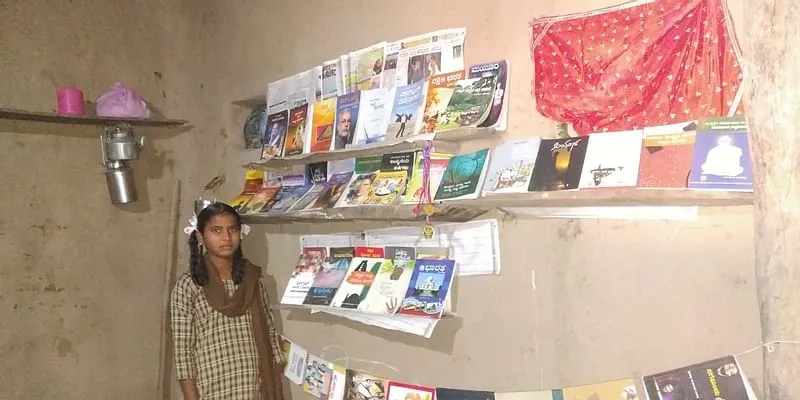Tata Trusts’ Parag Initiative has sparked the creation of home libraries by children in Yadgir
Nearly 24 students in the district have set up home libraries, and are now trying to spread their love for reading by sharing books with neighbours.
Nhina Begum, a grade 8 student from Kadechur Village in Yadgir district in Karnataka, has a home library with a small collection of books. Inspired by a vibrant school library and exposure to good children’s literature, Nhina’s favourite books are on display by her window side on a string. Nhina has created her book collection over time, gathering books from different sources.
“Never did I realise the importance of having books at home than when COVID-19 hit us, and we could not access the school library. Having books at home meant that reading could happen no matter what the outside situation was,” she shares.
Yadgir is among the districts that the Central government is focusing on for improving development. Its literacy rate of only 51.8% is lower than India’s least literate state (Bihar at 63.8%).

Image Credit: pixabay
In order to improve this situation of poor literacy, Tata Trusts’ Parag initiative set up 100 vibrant and active school libraries in Yadgir district. Through storytelling, book activities, community events and open access, the initiative has inspired a love for reading among many children.
The initiative also led to the creation of many home libraries, with Nhina and about 24 other children in the village collecting books and setting up their own libraries. These children have also let their neighbours have access to their home libraries, alongside ensuring proper hygiene norms during the pandemic.
Foundation to better literacy
The home libraries in Yadgir district are a result of an organic process - a long-term impact of Parag’s school library programme. Since 2016, Parag Initiative and Kalike, another initiative by Tata Trusts in the district, have worked jointly to set up active libraries across 100 schools in Yadgir.
“The process was slow and difficult. Since the aim was to build a reading culture that was absent, we had to begin by taking the idea of reading to teachers and principals. We set up infrastructure, brought the books and trained teachers to conduct book activities,” says Swaha Sahoo, Head, Parag Initiative, Tata Trusts
“Regular library periods became a part of the school timetable and children started borrowing books for home. Slowly, their confidence grew, they were able to talk about the books they liked, share books and discuss stories. All the children who have now set up home libraries in Yadgir today have experienced the possibility of a good library at school,” she adds.

Swaha Sahoo
Parag libraries are set up in some of the most difficult geographies of India, with an aim to build a reading culture. For example, Yadgir district has a literacy rate of 52 percent as compared to the state average of 75 percent. Most of the families either depend on daily wages or are engaged in agriculture. However, children between 6 to 14 years are the target audience.
The home libraries were the students’ personal initiative, encouraged as they were by access to good books and the impact that literature had on them. But, the true power of this initiative was felt during the pandemic, when all other outlets came to a standstill and learning was limited to home.
The children now lend their books and come together to read. Each child has a different collection of books, comprising story books, information books, magazines, etc. The books are available in English, Kannada and some of them are bilingual with both languages.
“Sometimes, children get together to read the same book, or older children read to younger siblings. At times, children choose one book and discuss it,” says Swaha.
Safe distribution during the pandemic
With the pandemic-induced lockdown, this activity took a life of its own. To ensure safety, all the participating children were trained and given instructions in physical distancing, sanitization of books (which are covered in plastic already for library use), and the safe handling and distribution of books from these libraries. Many children used windows and shelves in their houses to creatively set up the library.

Nhina Begum's home library
“Colourful strings, craft papers, and small decorative pieces in a corner are now a part of many living rooms in Yadgir district. Since the children could not attend school or play outdoors, home libraries, exchanging books and sharing stories brought them together and helped them stay connected to friends and neighbours,” says Swaha
Inspiring other states
The initiative has now begun in the Bali block of Rajasthan. The Parag Library Programme has ensured that children have access to literature and stories by distributing small book collections in villages. Through Children’s Library Management Committees, that are an essential part of Parag libraries, the team has ensured distribution of books from the Parag school libraries to the village.
“Bali has more than 40 percent Scheduled Caste (SC) and Scheduled Tribe (ST) population, and is one of the most challenged in terms of literacy levels of children. Parag supports 50 school libraries in the block, in collaboration with Centre for Microfinance, Jaipur,” says Swaha.
While parents of children in Bali were afraid that coronavirus could spread through this initiative due to contact with books, the children ensured that hygiene protocols were strictly followed.
“My friends and I sanitise the books that have been returned and do not let anyone touch them for a few days. I used to issue books to everyone in the school library. In the same way, now I distribute books to children near my house,” says Dalpat Choudhary, a class 5 student from Sesli, Rajasthan.
Like in Yadgir, many children here also created home libraries, and gather together to read books.
Edited by Anju Narayanan









